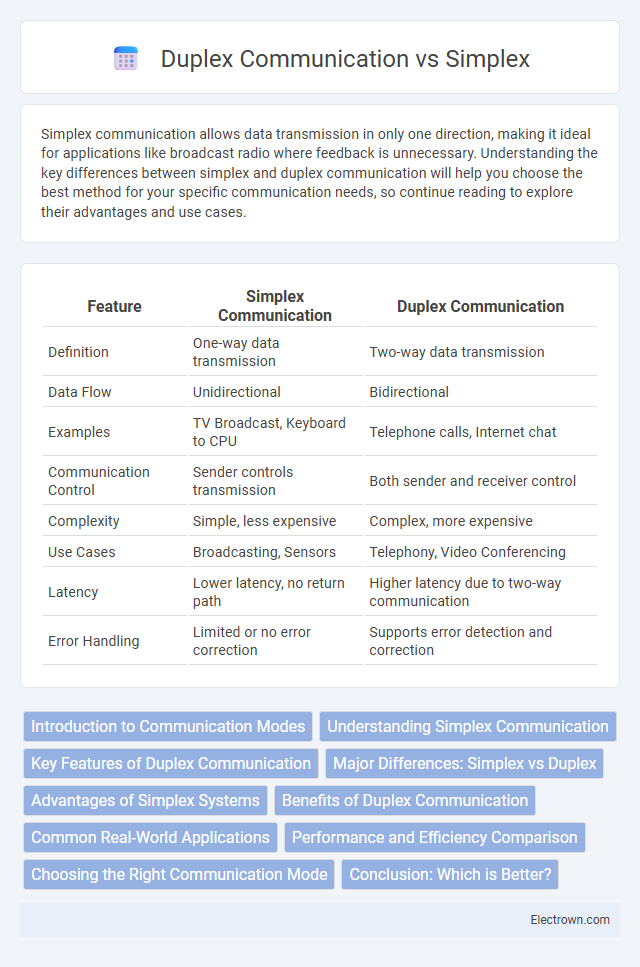Simplex communication allows data transmission in only one direction, making it ideal for applications like broadcast radio where feedback is unnecessary. Understanding the key differences between simplex and duplex communication will help you choose the best method for your specific communication needs, so continue reading to explore their advantages and use cases.
Table of Comparison
| Feature | Simplex Communication | Duplex Communication |
|---|---|---|
| Definition | One-way data transmission | Two-way data transmission |
| Data Flow | Unidirectional | Bidirectional |
| Examples | TV Broadcast, Keyboard to CPU | Telephone calls, Internet chat |
| Communication Control | Sender controls transmission | Both sender and receiver control |
| Complexity | Simple, less expensive | Complex, more expensive |
| Use Cases | Broadcasting, Sensors | Telephony, Video Conferencing |
| Latency | Lower latency, no return path | Higher latency due to two-way communication |
| Error Handling | Limited or no error correction | Supports error detection and correction |
Introduction to Communication Modes
Simplex communication allows data to flow in only one direction, making it ideal for applications like broadcast TV and keyboard inputs where feedback is unnecessary. Duplex communication supports two-way data exchange, enabling interactive processes such as telephone calls and video conferencing. Half-duplex systems permit bidirectional communication but restrict data flow to one direction at a time, commonly used in walkie-talkies and CB radios.
Understanding Simplex Communication
Simplex communication allows data to flow in only one direction, making it ideal for applications where information is sent from a transmitter to a receiver without the need for feedback, such as in keyboard to computer or television broadcast signals. This mode of communication simplifies design and reduces costs since it requires only a single communication channel. However, the lack of reverse communication limits its use to scenarios where interaction or data acknowledgment is unnecessary.
Key Features of Duplex Communication
Duplex communication enables two-way data transmission, allowing both sending and receiving of signals simultaneously or alternately, which enhances interaction efficiency. Full duplex systems transmit data in both directions at the same time, ideal for real-time communication like phone calls. Half duplex systems alternately send and receive data but cannot do both simultaneously, commonly used in walkie-talkies or CB radios.
Major Differences: Simplex vs Duplex
Simplex communication allows data to flow in only one direction, making it ideal for applications like keyboard inputs or broadcast signals where feedback is unnecessary. Duplex communication supports bidirectional data flow, enabling simultaneous two-way communication as seen in telephone conversations or video calls. The major difference lies in simplex's one-way transmission versus duplex's two-way interaction, impacting system complexity and use cases.
Advantages of Simplex Systems
Simplex communication systems offer significant advantages in terms of simplicity and cost-effectiveness, as they require only one communication channel, reducing both hardware complexity and power consumption. These systems are highly reliable for applications where one-way data transmission is sufficient, such as keyboard inputs and television broadcasts, ensuring minimal interference and signal disturbance. The unidirectional flow in simplex systems also enhances security by limiting the potential for data interception or unauthorized access.
Benefits of Duplex Communication
Duplex communication enables simultaneous two-way data transmission, enhancing real-time interaction and efficiency in communication systems. This continuous exchange reduces latency and improves collaboration, making it ideal for applications like video calls and online gaming. Your communication experience becomes more dynamic and responsive, supporting seamless information flow.
Common Real-World Applications
Simplex communication is commonly used in scenarios where information flows in one direction, such as television broadcasting, radio transmissions, or keyboard inputs. Duplex communication supports two-way interaction, essential for applications like telephone calls, video conferencing, and walkie-talkies, where simultaneous sending and receiving of data occurs. Your choice between simplex and duplex depends on whether uninterrupted bidirectional communication is required for the specific application.
Performance and Efficiency Comparison
Simplex communication transmits data in one direction only, resulting in lower latency but limited interaction, which can improve efficiency in unidirectional data flows like broadcast systems. Duplex communication supports two-way data transmission, enhancing performance in interactive applications by allowing simultaneous or alternate data exchange, though it may consume more bandwidth and require more complex protocols. Overall, duplex systems offer higher communication efficiency and adaptability for dynamic environments, while simplex systems are optimized for simplicity and minimal resource usage.
Choosing the Right Communication Mode
Choosing the right communication mode depends on your specific application requirements, such as data flow direction and interaction needs. Simplex communication allows data transmission in only one direction, making it ideal for devices like keyboards or sensors that only send data. Duplex communication enables two-way data exchange, essential for real-time interactions like phone calls or online gaming, ensuring efficient and dynamic communication.
Conclusion: Which is Better?
Duplex communication is generally better for most applications because it allows simultaneous two-way data transmission, enhancing efficiency and real-time interaction. Simplex communication, while simpler and cost-effective, is limited to one-way data flow, making it suitable only for specific scenarios like broadcasting. Your choice depends on whether bidirectional communication is essential for your system's performance and functionality.
Simplex vs Duplex Communication Infographic

 electrown.com
electrown.com